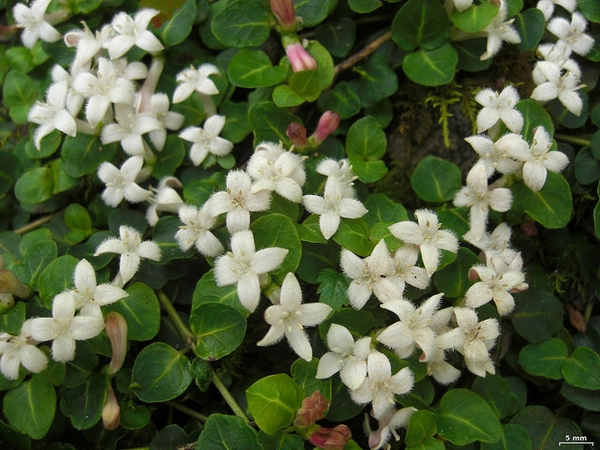Brighten Shade and Winter Gardens with Partridgeberry
by Janet Scheren, Fairfax Master Gardener
What can be better than a beautiful native, low growing, evergreen groundcover — especially one that produces white flowers in early summer, followed by bright red berries? Only one that found its way into your backyard for free!

Partridgeberry flower
Partridgeberry (Mitchella repens) is native to bottomlands, stream-banks and other wet habitats throughout eastern and central North America. I discovered this gorgeous native plant in my backyard about 10 years ago, and I now enjoy several large patches in my shady garden beds.
This plant is truly unique. The stems run along the ground in a vine-like fashion often carpeting an area. The dark-green, evergreen leaves are about a half inch across with a pale-yellow ribbing. In late spring, a pair of white flowers appears on short stems. Each small, fragrant flower has four bright white petals that come together in a funnel-shaped tube. One of the flowers in the pair has a short pistil and long stamens. The other has a long pistil and short stamens. This arrangement prevents flowers from self fertilizing. Further complicating the scheme, both flowers must be pollinated to obtain a single scarlet berry. Each berry results from the fusion of a pollinated pair of flowers. If you look closely you’ll notice that each berry has two bright red spots on its surface.
Partridgeberry is a well-mannered, slow spreader, which does not climb but rather lays prostrate on the forest floor. In fact, it is so low to the ground that you can run a lawnmower over it without damage. It spreads from nodes along its trailing stems that contact the forest floor and can grow into colonies several yards across. Both its flowers and stems are aromatic and freshen up the whole yard. Later in the season, the little red berries add even more interest. And the berries can last all winter.
Partridgeberry loves deciduous and coniferous forests with rich organic soils with dappled sunlight to complete shade. It is well-suited to dappled, part or full shade with moist, well-draining soil. It tolerates some minimal foot traffic. Because of its diminutive size and slow growth habit, partridgeberry works well in small, prominent areas where its interesting foliage, flowers and fruit can be seen and admired. It is often grown at the edge of paths, ponds or streams. I have used it along paths and around seating areas where both its visual appeal and fragrance can be appreciated.

Partridgeberry
Partridgeberry was the Virginia Northern Neck Native Plant Society February 2022 Plant of the Month, and the Virginia Native Plant Society Plant 2012 Wildflower of the Year.
Although the seeds will sprout two years after maturing, it’s best to grow this from one-year-old cuttings. Once established they are relatively trouble free with the only required maintenance of keeping garden debris from covering the mats. So you will want to be sure to remove any cover of leaves in fall.
Partridgeberry can also be started from division of established clumps. If you know of a native stand or have a friend who has it, ask for a few stems. The adventitious roots at the node of each leaf enable new cuttings to establish quickly. As always, do not wild collect plants from public lands and only from private lands with the owner’s permission. Partridgeberry is a commonly available plant from native plant nurseries especially those that specialize in woodland plants.
If you want to try to propagate this plant from berries, you will need to stratify berries for three months at about 40°F (4°C). Inside a refrigerator is ideal. After stratification, remove pulp from the seeds and sow them in damp sand. Pot seedlings up when they are large enough to handle, then add them to your landscape the following spring.
Birds are the primary consumer of these fruits and, like acorns, their primary seed distributors. They draw woodland creatures and birds to come for a visit and a berry snack. However, both the leaves and berries are edible for humans. Native Americans made the leaves into a tea. The berries are rather bland, but they are high in vitamin C, tannin, anthocyanins and antioxidants. As such, they can be used in any culinary dish for added nutrition and visual appeal.
Partridgeberry (Mitchella repens) is a woody herb that is a member of the Rubiaceae (madder) family. Its cousins include the fragrant gardenia, quinine, coffee, ipecac, buttonbush, Bouvardia and bluettes to name a few.
Resources
Partridge-berry Is Bright All Year, Virginia Native Plant Society
Mitchella repens, North Carolina State Extension Gardener Plant Toolbox
Plant of the Week, U.S. Forest Service